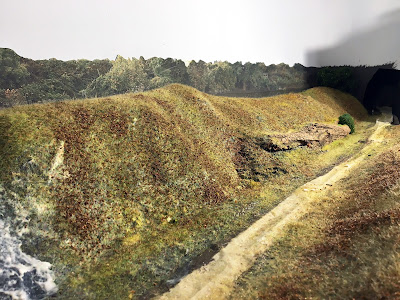So as February comes to a close, scenery progress continues on the M&E. Slowly and surely this side of the aisle is coming to match the level of scenery over on Conrail.
Once the paint dried, I used my mixture of diluted white glue painted over the slopes, and began to add static grass to represent the early fall. On steeper slopes I used full strength glue to allow for better adhesion and less glue runoff.
After the grass is down I added some brown leaf flocking, as this will be forest floor area. Everything was misted with isopropyl alcohol and a spray of diluted white glue, after which time I can remove the masking from the track areas.
It is neat to see the track area suddenly surrounded by foliage!
I ballasted the track with a combination of cinders, yard ballast, and some 'Northern Pacific Gray' from Arizona Rock & Mineral, and added some weeds and another light passing of the static grass to tie it all together. Ballast was glued down with my usual mix of diluted white glue and isopropyl alcohol. Now it's time to add trees to the forest, a final touch along with some trackside details: the CR block limit sign, the old DLW milepost (Thanks, Al!) and old T-box.
The ditches are lined with grasses more green in color, suggesting wetter soil at the base of the rock face and along the tracks. The trees do a nice job hiding the backdrop transitions.
As this area greens up, progress turns to the yards at Euclid including some industries. Stay tuned for an update on the 'new' look at Central Plastics!
~RGDave













